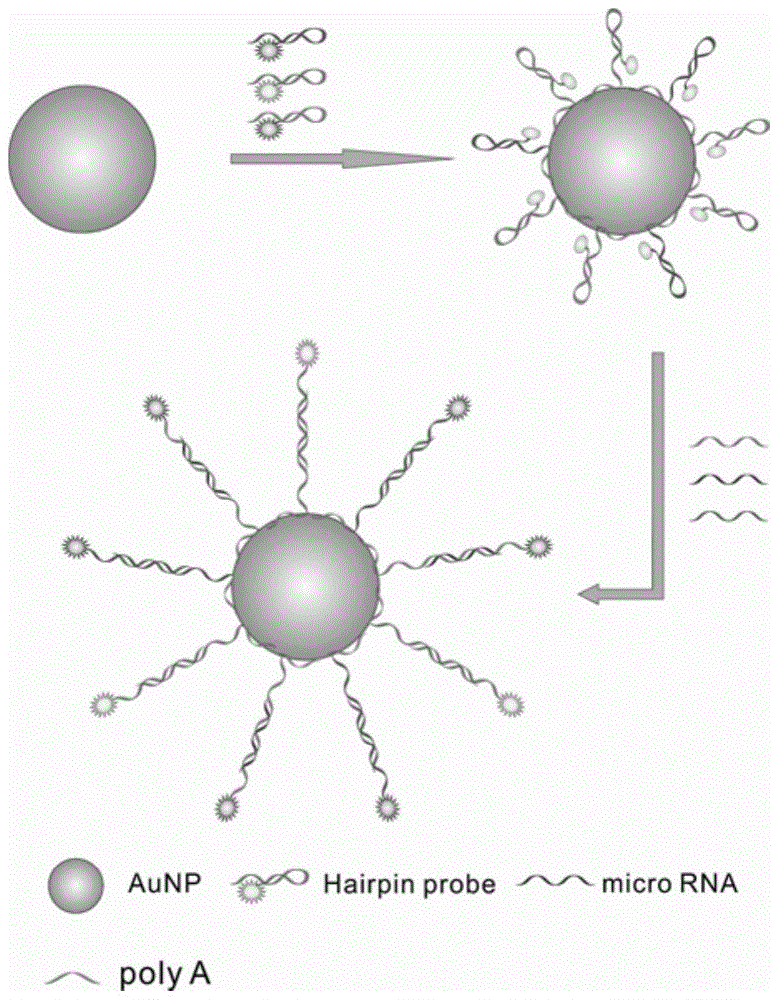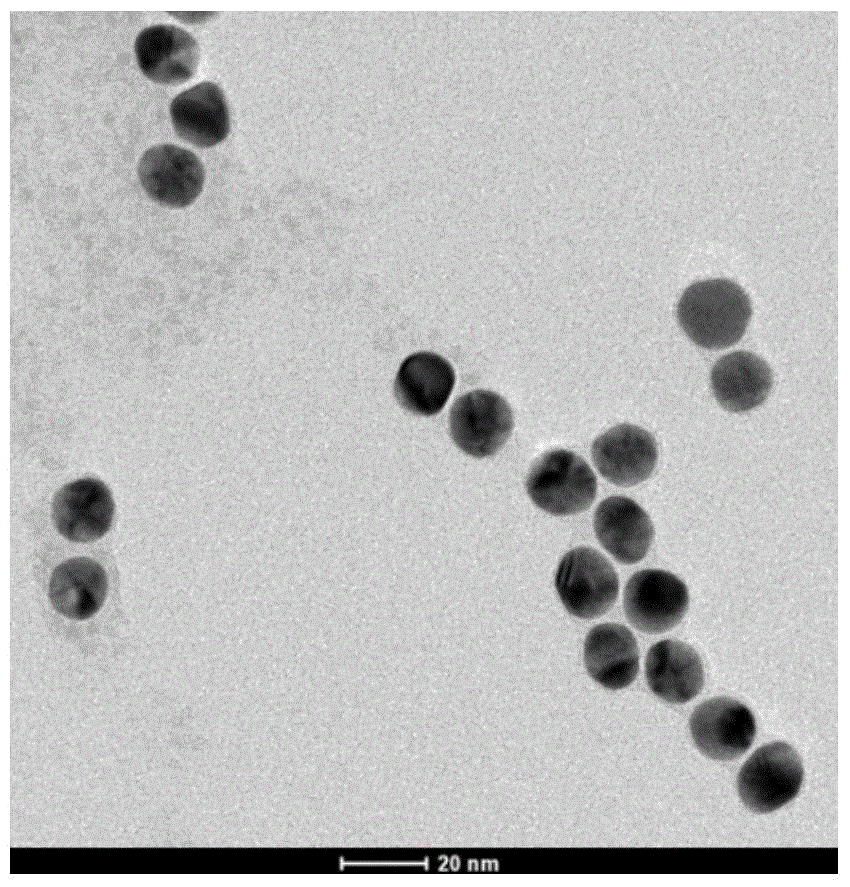A nano-gold based molecular beacon and its preparation and application
A molecular beacon and nano-gold technology are applied in the fields of multicolor molecular beacons and their preparation and application, which can solve the problems of poor specificity and low efficiency, and achieve the effects of simple method, maintaining stem-loop structure and improving hybridization efficiency.
- Summary
- Abstract
- Description
- Claims
- Application Information
AI Technical Summary
Problems solved by technology
Method used
Image
Examples
Embodiment 1
[0075] (1) Materials and equipment
[0076] Chlorauric acid (HAuCl4 4H2O, 99.99%), trisodium citrate, phosphate, NaCl, MgCl2, KCl, Milli-Q water; transmission electron microscope (TEM), UV spectrophotometer (Hitachi U-3010), fluorescence Spectrophotometer (F-4500, Hitachi), PH meter, refrigerated high-speed centrifuge (Hitachi); molecular beacons were purchased from Sangon Bioengineering (Shanghai) Co., Ltd. and purified using high performance liquid chromatography, target molecules (miRNA) Purchased from Yingwei Jieji (Shanghai) Trading Co., Ltd.
[0077] (2) Preparation and characterization of gold nanoparticles (AuNPs)
[0078] Nano gold (AuNPs) can be prepared with reference to the methods described in the following documents, references:
[0079] K.C. Grabar, R.G. Freeman, M.B. Hommer, M.J. Natan, Analytical
[0080] Chemistry 1995, 67, 735.
[0081] That is, gold nanoparticles were synthesized by a citric acid reduction method. The basic steps are as follows: add 1 ...
Embodiment 2
[0084] The molecular beacon for miR155 was originally designed, the ring region of the molecular beacon can specifically bind to miR155, the 5' end of the molecular beacon is connected to the FAM fluorescent group, and the 3' end is connected to PolyA10 (that is, 10 consecutive A base). In order to allow the molecular beacon to form a secondary stem-loop structure, the fluorescent probe has a certain distance from the surface of gold nanoparticles, so that its conformation remains upright to facilitate hybridization. Consecutive T bases.
[0085] A fluorescent probe with 5 consecutive T bases and PolyA10 connected to the 3' end
[0086] 5’-FAM- CGCTGC ACCCCTATCACGATTAGCATTAA GCAGCG TTTTTAAAAAAAAAAA-3' (100uM, 1.8uL) was co-assembled with AuNPs (3nM, 200uL) and incubated for 16h. Add 22ul of salt (1M NaCl, 100mM PB) and incubate for 24h. Centrifuge and wash (0.1M PBS).
[0087] The final molecular beacon is:
[0088] 5’-FAM- CGCTGC ACCCCTATCACGATTAGCATTAA GCAGCG TTT...
Embodiment 3
[0091] (1) Then use other methods to design a molecular beacon against miR155, the ring region of the molecular beacon can specifically bind to miR155, the 5' end of the molecular beacon is connected to a FAM fluorescent group, and the 3' end is connected to PolyA10 (also That is, 10 consecutive A bases) or PolyA20 (ie, 20 consecutive A bases). Direct connection between PolyA10, PolyA20 and the 3' end of the fluorescent probe without T base.
[0092] A fluorescent probe that connects the 3' end to PolyA10
[0093] 5’-FAM- CGCTGC ACCCCTATCACGATTAGCATTAA GCAGCG AAAAAAAAAAA-3' (100uM, 1.8uL) was co-assembled with AuNPs (3nM, 200uL) and incubated for 16h. Add salt (1M NaCl, 100mM PB) 22ul, and incubate for 24h. Centrifuge and wash (0.1M PBS).
[0094] The final molecular beacon is:
[0095] 5’-FAM- CGCTGC ACCCCTATCACGATTAGCATTAA GCAGCG AAAAAAAAAAA-Au-3' (SEQ ID NO.2), denoted as Molecular Beacon 3-1.
[0096] A fluorescent probe that connects the 3' end to PolyA20
[0...
PUM
| Property | Measurement | Unit |
|---|---|---|
| particle diameter | aaaaa | aaaaa |
Abstract
Description
Claims
Application Information
 Login to View More
Login to View More - R&D Engineer
- R&D Manager
- IP Professional
- Industry Leading Data Capabilities
- Powerful AI technology
- Patent DNA Extraction
Browse by: Latest US Patents, China's latest patents, Technical Efficacy Thesaurus, Application Domain, Technology Topic, Popular Technical Reports.
© 2024 PatSnap. All rights reserved.Legal|Privacy policy|Modern Slavery Act Transparency Statement|Sitemap|About US| Contact US: help@patsnap.com










